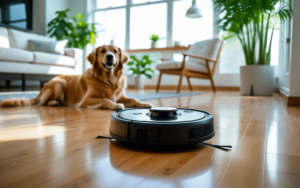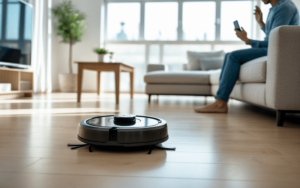With energy costs continually rising, homeowners are increasingly turning to smart technology for effective solutions.
Smart home devices not only enhance convenience and comfort but also play a crucial role in reducing energy consumption.
As smart home technology advances, numerous options are available that cater specifically to energy efficiency. These innovative gadgets adapt to user habits, providing optimal control over energy usage.
From intelligent thermostats that learn schedules to smart plugs that monitor consumption, each device contributes to a more sustainable and cost-effective living environment.
Exploring the best smart home devices for saving money on energy bills can help homeowners make informed choices, ensuring that their investment translates into long-term savings. This article will highlight the most effective devices designed to lower energy costs while enhancing home automation.
Evaluating Your Home’s Energy Efficiency
Understanding the energy efficiency of a home is essential for identifying areas where energy savings can be realized.
By focusing on specific smart devices, homeowners can significantly lower their energy costs.
Smart Thermostats
Smart thermostats are pivotal in managing home heating and cooling effectively. They learn user preferences and create schedules, optimizing energy use based on occupancy.
Key features often include:
- Remote Access: Users can control settings via smartphone apps, even when away from home.
- Adaptive Learning: These devices adjust automatically, adapting to lifestyle changes.
- Energy Reports: Many units provide insights into energy consumption, helping homeowners identify savings opportunities.
For instance, a smart thermostat can reduce heating or cooling when the home is unoccupied, leading to notable reductions in utility bills. Additionally, some models integrate with HVAC systems to enhance efficiency further.
LED Lighting Solutions
Switching to LED lighting is one of the simplest ways to improve energy efficiency.
LED bulbs consume significantly less energy than traditional incandescent bulbs, providing an excellent return on investment.
Consider these advantages:
- Longevity: LEDs last up to 25 times longer than incandescent bulbs, reducing replacement frequency.
- Lower Heat Emission: They emit minimal heat, making them safer and more efficient.
- Variety of Options: From smart bulbs that can be dimmed or color-changed to standard LED replacements, homeowners have various choices.
By replacing all lighting with LEDs, a household can save approximately 75% on lighting costs annually, which can translate into substantial savings over time.
Energy Monitoring Systems
Energy monitoring systems give homeowners insight into their electrical consumption. These devices track usage patterns and provide detailed reports, making it easier to identify inefficiencies.
Key components include:
- Real-Time Monitoring: Users get live updates about their energy use.
- Alerts: Notifications about unusual spikes in usage can indicate issues.
- Analytics: Monthly reports help track energy consumption trends, allowing for informed adjustments.
With this information, homeowners can make strategic changes, like turning off unused devices or planning the use of high-consumption appliances at off-peak hours. This proactive approach can lead to considerable energy savings and lower overall bills.
Heating and Cooling Innovations
Innovations in heating and cooling technologies can significantly enhance energy efficiency in smart homes. These advancements offer homeowners improved control over their environments while reducing energy consumption and costs.
Smart HVAC Systems
Smart HVAC systems are designed for optimal performance and energy management. They adapt to user preferences and patterns, using sensors and algorithms to adjust heating and cooling in real-time.
Key features include:
- Remote Control: Homeowners can manage their systems through mobile apps.
- Energy Usage Reports: Detailed insights help users understand their consumption patterns.
- Zoning Capabilities: This allows different areas of a home to be heated or cooled independently.
This technology can lead to annual savings of $130 to $150, as outlined in a recent report on smart home devices for energy efficiency.
Automated Insulation Solutions
Automated insulation systems provide an innovative way to enhance energy conservation. These systems adjust insulation levels based on external temperatures and internal needs.
Features include:
- Dynamic Insulation Materials: Some materials can expand or contract based on temperature.
- Integration with Smart Thermostats: Seamless collaboration with smart thermostats to optimize heating and cooling processes.
- Real-Time Monitoring: Users can receive alerts on insulation performance.
Such solutions ensure that homes maintain consistent temperatures, reducing the strain on HVAC systems and lowering energy expenses.
Intelligent Window Treatments
Intelligent window treatments minimize heating and cooling costs by effectively managing sunlight and temperature. These solutions can be automated to respond to changes in light or weather conditions.
Key advantages include:
- Smart Blinds and Shades: Automatically adjust according to time of day or sunlight exposure.
- Energy Efficiency: They can reduce heat gain in summer and retain warmth in winter.
- Remote Access: Users can control their window treatments from anywhere using smart devices.
By optimizing natural light and temperature control, intelligent window treatments can lead to substantial savings on energy bills while enhancing comfort in the home.
Smart Appliances and Energy Management
Smart appliances and energy management solutions are crucial for homeowners looking to reduce energy costs. These innovations offer enhanced efficiency, integrated systems, and the capability to harness renewable energy sources.
High-Efficiency Smart Appliances
High-efficiency smart appliances are designed to use significantly less energy than traditional models.
Appliances such as smart refrigerators, washers, and dryers feature advanced technologies that optimize performance while minimizing energy consumption.
For instance, smart washers can automatically adjust water levels based on load size, while refrigerators may use sensors to regulate temperature and reduce energy use. These efficiencies translate into substantial savings on utility bills over time.
Many of these appliances also offer energy usage data, allowing users to monitor and adjust their usage patterns. Homeowners can often find ENERGY STAR certified options that ensure top-tier performance without excessive energy consumption.
Integrated Smart Home Hubs
Integrated smart home hubs serve as central control systems for managing various smart devices. These hubs enable seamless communication between appliances, optimizing energy use through smart scheduling and automation.
For example, a smart thermostat can work in tandem with smart blinds. It may adjust heating or cooling based on the amount of sunlight entering a room, creating a more comfortable environment and saving energy.
By aggregating data from multiple devices, these hubs empower users to make informed decisions about their energy consumption. Many hubs are compatible with voice assistants, making them user-friendly and accessible.
Renewable Energy Integrators
Renewable energy integrators facilitate the effective use of alternative energy sources within smart homes. These systems allow homeowners to harness solar, wind, or other renewable energy, significantly reducing reliance on grid electricity.
Smart inverters and batteries can store excess energy generated during peak production times. This stored energy can then be used during high-demand periods, reducing energy costs considerably.
Additionally, some integrators offer real-time monitoring of energy generation and usage, helping homeowners optimize their energy consumption strategies. This capability ensures that users can make the most of the energy they produce, further lowering their bills and environmental impact.
Optimization and Maintenance
Effective optimization and maintenance of smart home devices are essential for maximizing their energy-saving potential.
Regular updates, remote diagnostics, and preventive alerts contribute substantially to energy efficiency and cost savings.
Software Updates and Optimization
Staying current with software updates is crucial for smart home devices.
Manufacturers often release updates that enhance functionality, improve security, and optimize energy efficiency.
He should regularly check for updates via device applications or manufacturer websites. Many devices offer automatic updates; however, ensuring these settings are enabled is necessary.
To optimize performance further, users can adjust settings to align with their energy usage patterns. For example, scheduling devices to operate during off-peak hours can result in considerable savings.
Remote Diagnostic Tools
Remote diagnostic tools are valuable for identifying issues without requiring on-site visits. These tools allow users to monitor performance metrics and receive real-time alerts regarding device malfunctions.
It is often possible to access these tools through associated mobile applications, providing insights into energy consumption patterns.
For instance, a smart thermostat might notify him of unusual energy usage, prompting further investigation. This proactive approach can help to address problems swiftly, ensuring devices run efficiently and maintain their energy-saving capabilities.
Preventive Maintenance Alerts
Preventive maintenance alerts play an integral role in sustaining device functionality.
Many smart home systems can send reminders for regular maintenance tasks.
For example, these tasks might include cleaning filters or checking connections.
Timely maintenance helps to prevent inefficiencies that could lead to higher energy costs.
Regular tasks might include changing the air filter on a smart HVAC system or checking for firmware updates.
Users can set these alerts based on calendar schedules or usage patterns.
This ensures that maintenance does not disrupt daily routines.
Implementing these preventive measures fosters a more sustainable and efficient smart home environment.
This ultimately translates to reduced energy bills.




